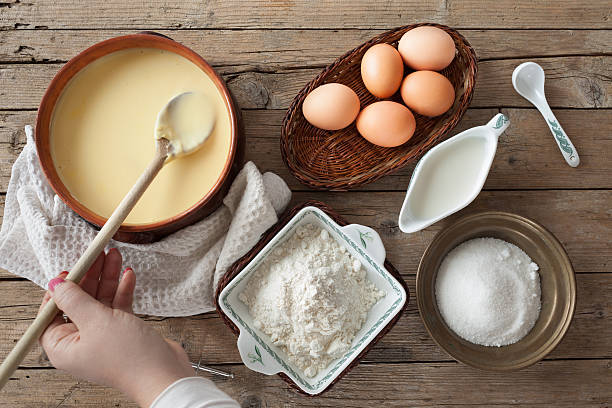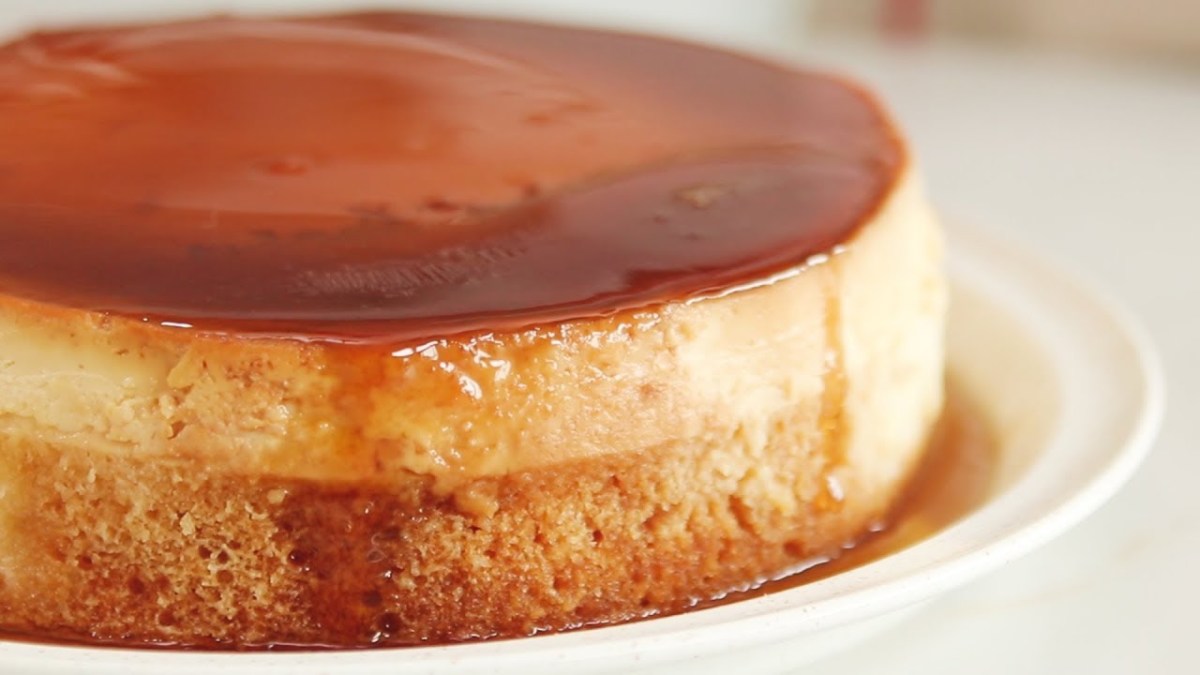

Crème caramel is a variant of plain custard (crème) where sugar syrup
cooked to caramel stage is poured into the mold before adding the custard
base. It is usually cooked in a bain-marie on a stovetop or in the oven in
a water bath. It is turned and served with the caramel sauce on top, hence
the alternate French names crème (caramel) renversée or crème renversée au
caramel. The milk may be flavored with vanilla, cinnamon, or lemon peel.
The resulting texture is gelatinous and creamy. Turning out larger dishes
requires care, as the custard easily splits. Larger dishes also require
more care to avoid undercooking the interior or overcooking the exterior.
Thus, crème caramel is often cooked and served in individual ramekins. The
objective is to obtain a homogeneous and smooth cream on the surface of
the crème caramel with a liquid caramel base. Cooking it in a bain-marie
avoids burning the caramel.
Preparation Crème caramel is a variant of plain custard (crème) where
sugar syrup cooked to caramel stage is poured into the mold before adding
the custard base. It is usually cooked in a bain-marie on a stovetop or in
the oven in a water bath. It is turned and served with the caramel sauce
on top, hence the alternate French names crème (caramel) renversée or
crème renversée au caramel. The milk may be flavored with vanilla,
cinnamon, or lemon peel. The resulting texture is gelatinous and creamy.
Turning out larger dishes requires care, as the custard easily splits.
Larger dishes also require more care to avoid undercooking the interior or
overcooking the exterior. Thus, crème caramel is often cooked and served
in individual ramekins. The objective is to obtain a homogeneous and
smooth cream on the surface of the crème caramel with a liquid caramel
base. Cooking it in a bain-marie avoids burning the caramel. Imitations An
imitation of crème caramel may be prepared from "instant flan powder",
which is thickened with agar or carrageenan rather than eggs. In some
Latin American countries, the true custard version is known as "milk flan"
(flan de leche) or even "milk cheese", and the substitute version is known
as just "flan".
Baked goods have been around for thousands of years. The art of baking was developed early during the Roman Empire. It was a highly famous art as Roman citizens loved baked goods and demanded them frequently for important occasions such as feasts and weddings. Because of the fame of the art of baking, around 300 BC, baking was introduced as an occupation and respectable profession for Romans. Bakers began to prepare bread at home in an oven, using mills to grind grain into flour for their breads. The demand for baked goods persisted, and the first bakers' guild was established in 168 BC in Rome. The desire for baked goods promoted baking throughout Europe and expanded into eastern parts of Asia. Bakers started baking bread and other goods at home and selling them on the streets. This trend became common, and soon, baked products were sold in streets of Rome, Germany, London, and more. A system of delivering baked goods to households arose as the demand increased significantly. This prompted bakers to establish places where people could purchase baked goods. The first open-air market for baked goods was established in Paris, and since then bakeries have become a common place to purchase delicious goods and to socialize. By the colonial era, bakeries were commonly viewed in this way. On July 7, 1928, a bakery in Chillicothe, Missouri introduced pre-cut bread using the automatic bread-slicing machine, invented by Otto Frederick Rohwedder. While the bread initially failed to sell, due to its "sloppy" aesthetic, and the fact it went stale faster, it later became popular.[3] In World War II bread slicing machines were effectively banned, as the metal in them was required for wartime use. When they were requisitioned, creating 100 tons of metal alloy, the decision proved very unpopular with housewives. World War II directly affected the bread industry in the UK. Baking schools closed during this time, so when the war ended there was a lack of skilled bakers. This resulted in new methods being developed to satisfy the world’s desire for bread, including chemical additives, premixes and specialised machinery. Old methods of baking were almost completely eradicated when these new methods were introduced and the industry became industrialised. The old methods were seen as unnecessary and financially unsound. During this period there were not many traditional bakeries left.


